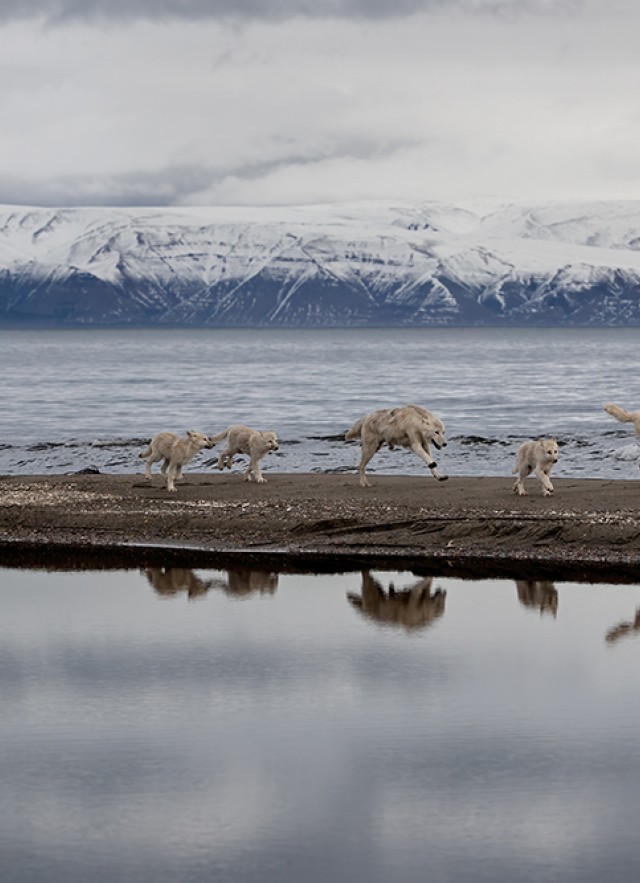Los Angeles, CA (August 22, 2024) — The Natural History Museum of Los Angeles County is proud to announce the debut of Wolves: Photography by Ronan Donovan on September 17, 2024. The traveling photography exhibit, created by National Geographic Society and the National Museum of Wildlife Art, will display Ronan Donovan’s stunning images and videos highlighting the contrast between wolves living in perceived competition with humans and those living without human intervention.
Wolves: Photography by Ronan Donovan will introduce visitors to wolves as seen by Donovan in the Greater Yellowstone Ecosystem and Ellesmere Island in the high Canadian Arctic. Visitors will see — in unparalleled intimacy — how the Arctic wolves hunt, play, travel, rest, and raise their young in one of the harshest environments on Earth. By contrast, their brethren in the Greater Yellowstone Ecosystem are fearful of humans, making it nearly impossible to document their daily lives. These differences can be attributed to the fact that Arctic wolves rarely experience negative encounters with humans or view them as a threat.
Since 2014, Donovan (a National Geographic Explorer and photographer of wild wolves) has examined the relationship between wild wolves and humans in order to better understand the animals, our shared history, and what drives the persistent human-wolf conflict.
“Wolves are such a fascinating animal to me because of how complex their relationship is with humans,” Donovan says. “Wolves were the first animals humans domesticated some 30,000 years ago, and they have lived alongside us ever since as guardians, workers, and companions. Yet as humans moved to more sedentary lives, raising what amounts to easy prey in the form of livestock, wolves have found themselves in conflict with humans.”
As wolves in North America are increasingly under threat due to recent extreme wolf-control laws, and humans continue to impinge on the land and food sources that these animals need to survive, Donovan hopes that his photos will provide people with a better understanding of these often misunderstood animals.
“Wolves have acquired some of the most complex social behavior during their long history of evolution over several million years,” says Dr. Xiaoming Wang, NHM’s Curator of Vertebrate Paleontology. “Such behaviors helped them become top predators in their communities. This exhibit both showcases Donovan’s unique perspectives and also illustrates how such a keystone species plays an outsized influence on the entire ecosystem.”
The visuals presented throughout Wolves: Photography by Ronan Donovan were captured from Donovan’s National Geographic Society-funded work and featured in National Geographic magazine’s 2016 Yellowstone issue and September 2019 issue, as well as the National Geographic WILD series Kingdom of the White Wolf in 2019.
The exhibition is on view at NHM through June 22, 2025 in a newly-renovated gallery that connects to the museum’s new wing and community hub, NHM Commons.
About the Natural History Museums of Los Angeles County:
The Natural History Museums of Los Angeles County (NHMLAC) include the Natural History Museum, La Brea Tar Pits, and the William S. Hart Museum. They operate under the collective vision to inspire wonder, discovery, and responsibility for our natural and cultural worlds. The museums hold one of the world’s most extensive and valuable collections of natural and cultural history—more than 35 million objects. Using these collections for groundbreaking scientific and historical research, the museums also incorporate them into on- and offsite nature and culture exploration in L.A. neighborhoods, and a slate of community science programs—creating indoor-outdoor visitor experiences that explore the past, present, and future. Visit NHMLAC.ORG for adventure, education, and entertainment opportunities.
About Ronan Donovan:
A field biologist turned conservation photographer and filmmaker, Ronan Donovan has explored the human relationship to nature and wildlife on all seven continents. Donovan's passion for conserving wild animals and wild places was ignited as a child growing up in Vermont and later during his years as a wildlife field biologist researching spotted owls and chimpanzees. He transitioned to visual storytelling as a way to amplify the wildlife researchers and conservationists that Donovan collaborated with. In addition to his National Geographic work on wolves, Donovan has documented human-chimpanzee conflicts in Uganda, and the legacy work of primatologist Dian Fossey focused on mountain gorillas in Volcanoes National Park, Rwanda. Donovan strives to reconnect viewers to the natural world through the lives of our fellow social mammals to highlight our shared past and interwoven future.
About the National Museum of Wildlife Art:
Founded in 1987, the National Museum of Wildlife Art is located in Jackson Hole, Wyoming. Their permanent collection contains more than 5,000 artworks representing wild animals from around the world, and chronicling much of the history of wildlife in art, from 2500 B.C.E. to the present. The Museum's mission is to impart knowledge and inspire appreciation of humanity’s relationship with wildlife and nature through art and education.
Media Contacts
Amy Hood
213-763-3532
ahood@nhm.org
Josh Chesler
213-763-3580
jchesler@nhm.org
WOLVES: PHOTOGRAPHY BY RONAN DONOVAN IS AN EXHIBITION FROM
LEAD PATRON


